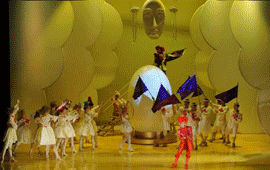> [Archived] Chronicles

For The First Time...
In mid-November I had the chance to be present at a quite special event. The Iași National Opera held its opening night at the National Theatre, premises whose regained beauty and elegance crowned the absolute novelty of the show. Rameau's opera-ballet Les Indes Galantes directed by Andrei Șerban made its debut at The Lyric Theater in Iași. The performance, which used to be held in Paris, was hosted on this new stage where the entire production view was adapted to fit its capacity and equipment. The dynamics of the show were enriched by the generous presence of the choristers and even of the soloists, along with the choreography which was taken over from Blanca Li.
Actually, both the luxurious scenography of Marina Drăghici and the staging brim over with creativity, wit, humour, charm and good taste which have turned a Baroque opera clogged with arias, static duets and chamber dances into a breath-taking show.
The empty stage is successively "embellished" with small clouds and a carved "tree", a mobile ladder, an enormous "golden" bird, a huge "egg" that breaks open in 4 "slices" which are meant to suggest the premises of each part. Moreover, the globe-like balls that are rolled by the performers or the brilliant "waves" of the wrathful ocean "cover" the space without making it look laden with props; the exuberant and suggestive costumes enlivened by the adorned "shields", by masks, "small boats", flowers or "peace pipes" and so on and so forth bring a rarely vivacious colouring value and a preciously graphic interpretation.
Andrei Șerban's way to place the light in a refined and efficient manner led to the outlining of its importance in the performance; together with Nicky Woltz, he also directed the staging-that bursts into taste and fascinating eloquence- with which the background and the numerous, diverse dances go hand in hand. This mise-en-scène explores the performers' rendering who seem utterly excited to get involved in that universal play.
As far as the choir is concerned, the director came up with energy by making them dance and gesticulate whilst singing (well done) a quite hard and prolonged part (choir master: Mirel Azamfirei). The theatre's dancers discovered the enchantment of those which are far from being "chamber dances" (although there are parts where the dresses, the "period" wigs and the traditional bows do appear) only to become -in a couple of shakes- sailors who ride the "waves" and meet the "mermaids", the "red Indians" or the pretty-fierce "Ottomans"; the props are made up of flowers with their head and feet outside the "pots" and the figurant who pulls a minaret here and there and so on and so forth. There is a continuous game in which the audience gets involved though a few tricks of the trade like the placing of some characters among the house (even in boxes). The difficulty of such an endeavour is achieved professionally and in such a contagious cheerfulness that beautifully veils the effort and exhaustion.
Love hovers overhead like a "mandatory" God of Love who shoots arrows and keeps the lovers together despite those "bad characters" who wish the opposite and who suffer defeat or…who repent in the end. To each prototype of the hero is lent credence through its content or even through the way it is rendered. The soloists try to perform the pre-classic works in a precise manner and their struggle to overcome the trials of this domain is praiseworthy. The outcome of their attempt resulted in a fine rendering of the score due to their firm voices which are often ample and capable to phrase or to place emphasis on the accents as well as to be in tune with the ensembles or to accomplish the recitatives.
The numerous and balanced cast should be mentioned entirely, mainly because most of them are "the theatre's soloists". A round of thunderous applauses were given for Ana-Maria Donose, Lăcrămioara Hrubaru-Roată, Mihaela Grăjdeanu, Diana Bucur, Adrian Ionescu -who was a pleasant surprise-, Rodica Vică and Jean-Kristof Bouton (both recent graduates of the National University of Music in Bucharest, this time they were given the roles that fit better their vocal qualities), Daniel Mateianu, Octavian Dumitru, Andrei Fermeșanu, Radmilo Petrovic (from Vienna), Cristina Grigoraș, Alexandru Savin, Mihail Frunză. The opening was conducted by Adrian Morar (the concertmaster was the violinist Mihai Ghiga from Bucharest who has a degree in ancient music); due to Adrian Morar's sound rigour the orchestra blended perfectly in with the choir and the soloists; they strove to meet the requirements of such scores that are not usually used.
Hardly did I feel so excited about a show or did I revel with such pleasure and curiosity in a three-hour performance so to catch every meaning, detail, symbol or gist of what was rendered with such generosity and talent making us to believe that a Baroque work can be indeed performed in a fluent, glamorous, dynamic and sophisticated manner without any shade of "thickening" or overstressing. It was more like a witty joke that was spreading around infinite ideas which came to life due to the unexpected interpretation of the ensemble.
The first production of the Iași Opera on "its home stage" truly represented a huge surprise both for the sceptical, yet captivated audience and for those who rediscovered Andrei Șerban's gift to express himself in a new manner which was thoroughly applauded by the full house. Only time could say how further shows would be evaluated or for how long would the show be going in production…
Translated by Sorina Cimpoeru and Elena Daniela Radu
MTTLC, Bucharest University














